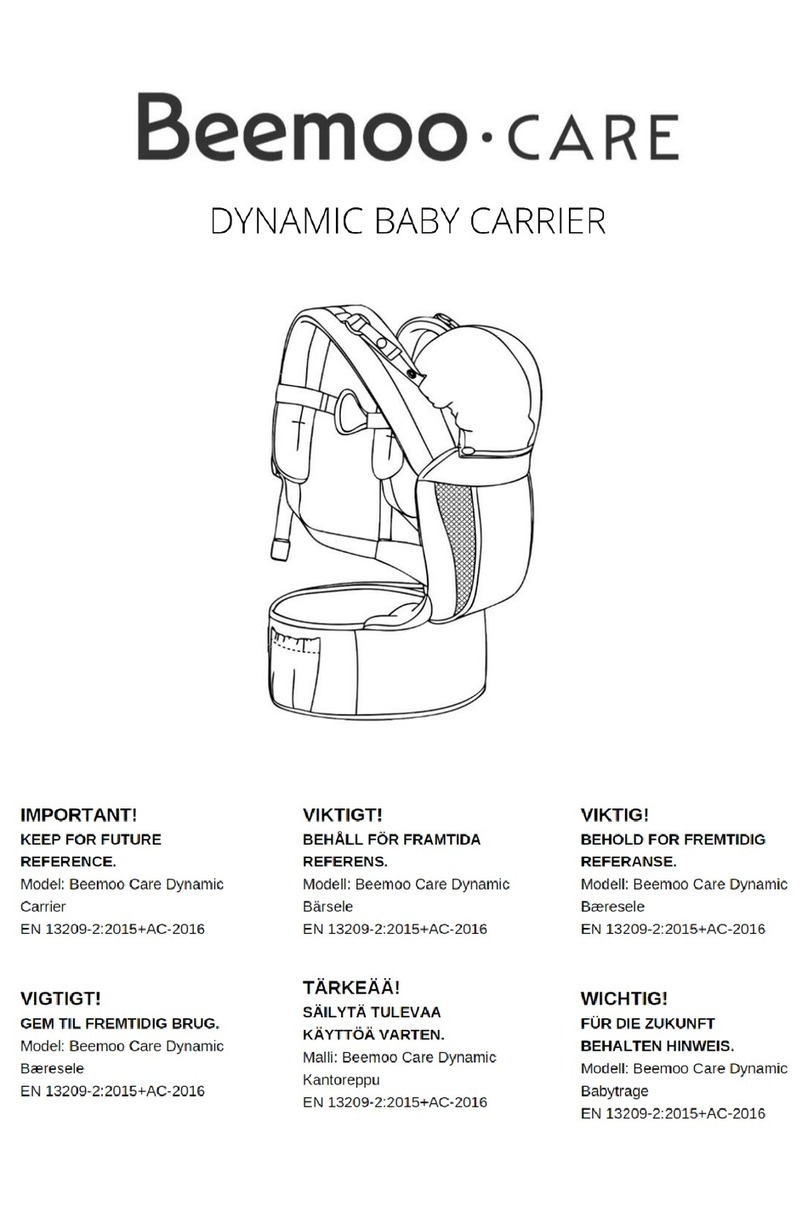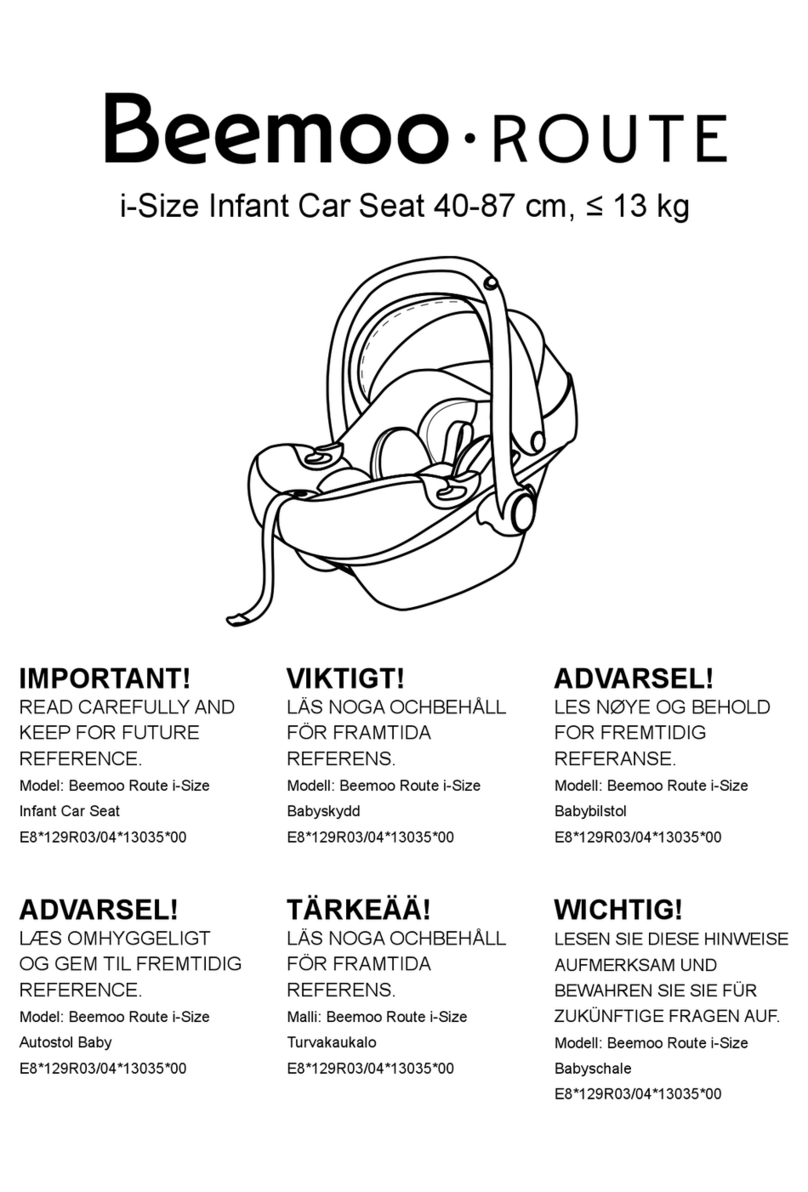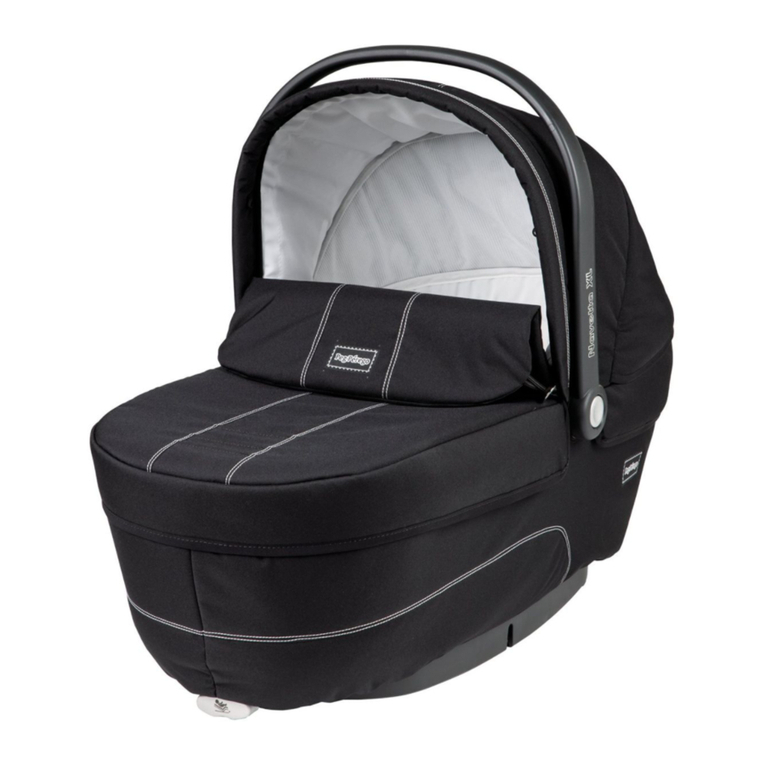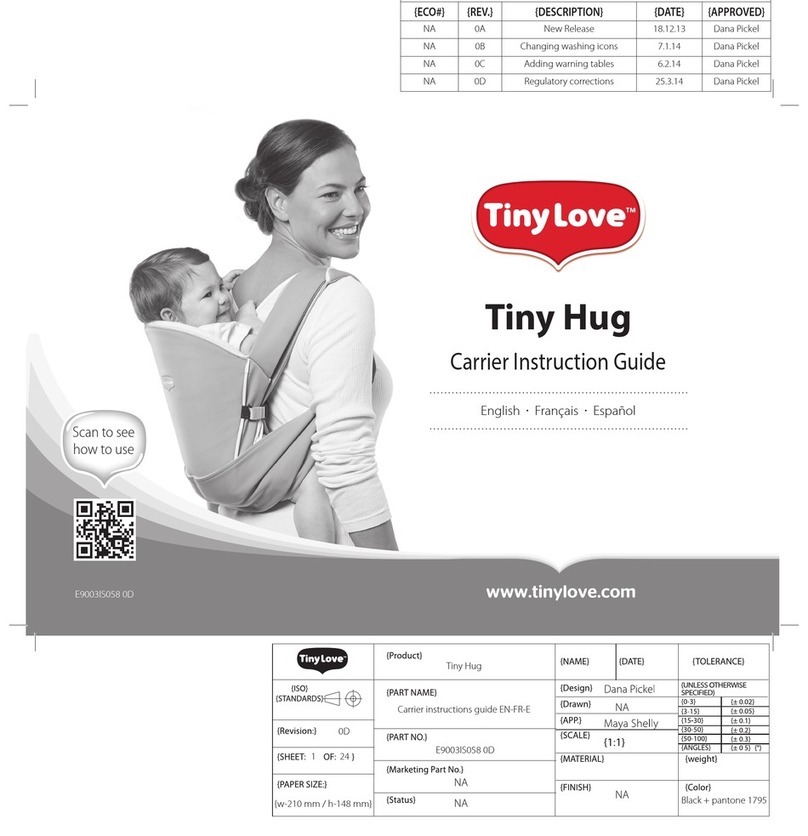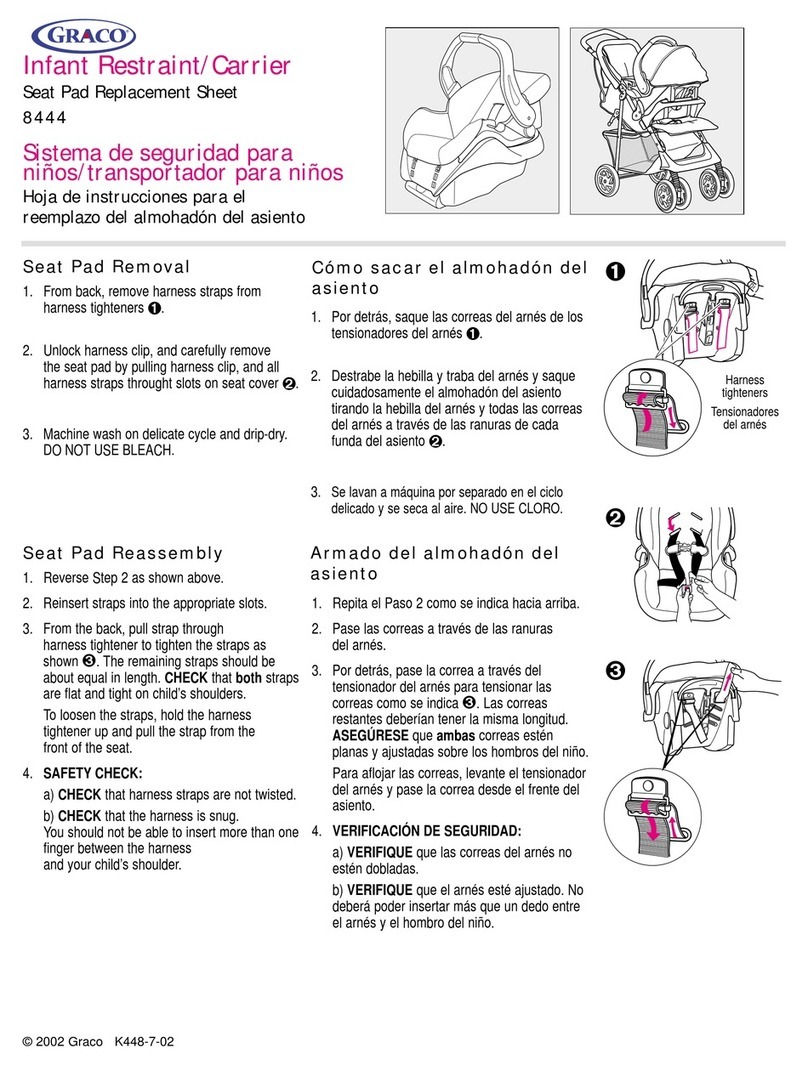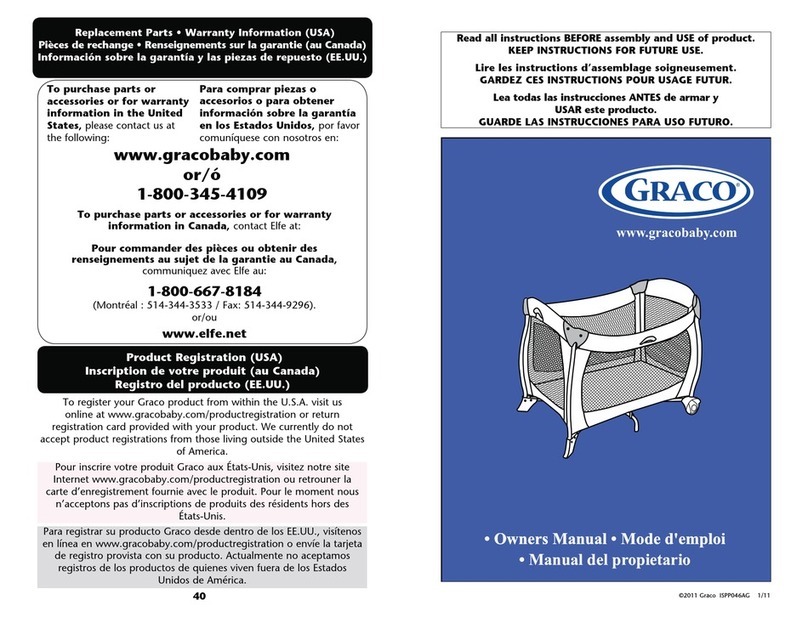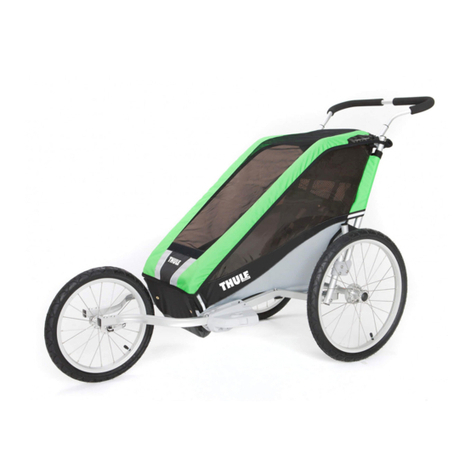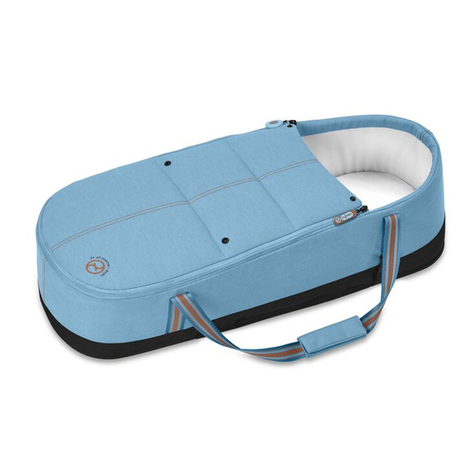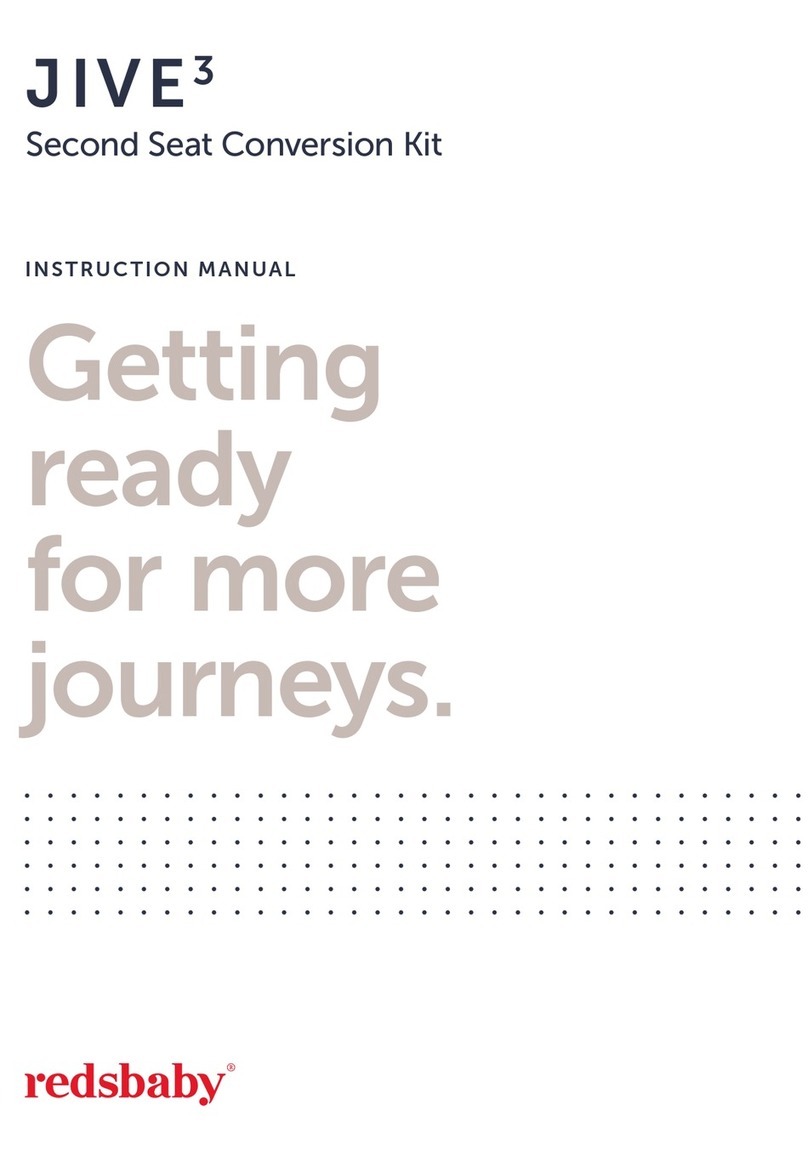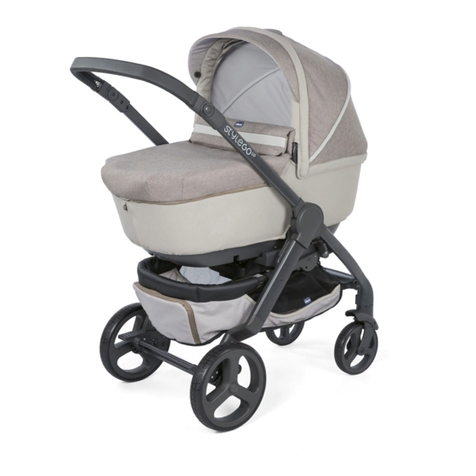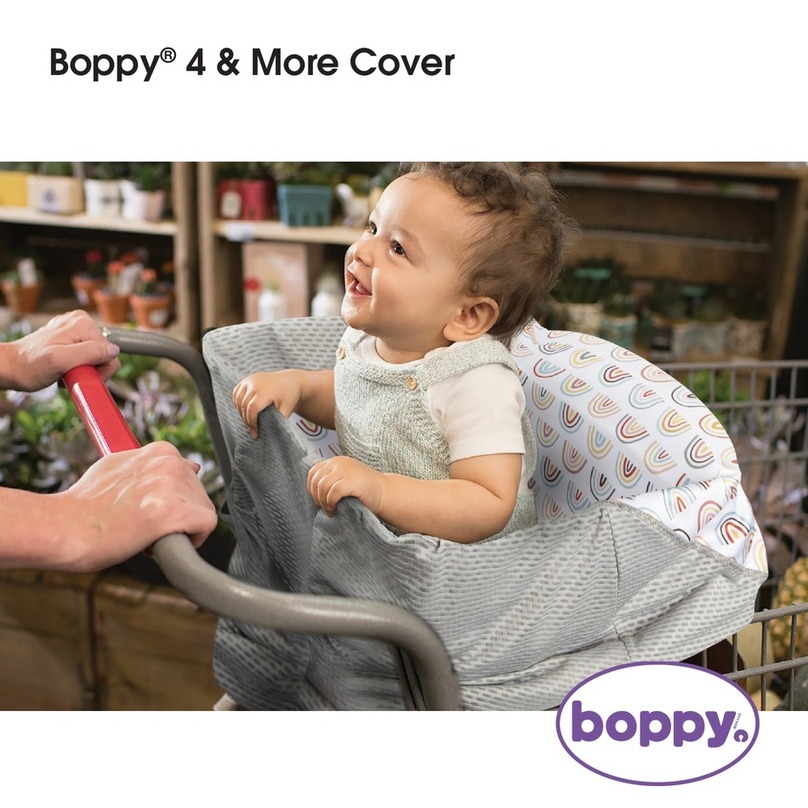Beemoo CARRY COMFORT User manual


2
1. WARNING
IMPORTANT! READ CAREFULLY AND KEEP FOR FUTURE
REFERENCE
WARNING - Your balance may be adversely affected by your
movement and that of your child.
WARNING - Take care when bending or leaning forward or
sideways.
WARNING - This carrier is not suitable for use during sporting
activities.
WARNING - When using the soft carrier monitor your child.
WARNING - For low birthweight babies and children with medical
conditions, to seek advice from a health professional before using
the product.
WARNING- An awareness of hazards in the domestic
environment e.g., heat sources, spilling of hot drinks.
WARNING - Stop using the carrier if parts are missing or
damaged.
IMPORTANT
•Baby must face you until he or she can hold head
upright.
•Premature infants, infants with respiratory problems, and
infants under 4 months are at greatest risk of suffocation.
•Never use a soft carrier when balance or mobility is
impaired because of exercise, drowsiness, or medical
conditions.
•Never wear a soft carrier while driving or being a
passenger in a motor vehicle.
•Never use a soft carrier while engaging in activities such
as cooking and cleaning which involve a heat source or
exposure to chemicals.

3
•The baby carrier is NOT suitable for use during sports or
other leisure activities.
•Check to assure all buckles, snaps, straps, and
adjustments are secure before each use.
•Check for ripped seams, torn straps or fabric and
damaged fasteners before each use.
FALL HAZARD
•Infants can fall through a wide leg opening or out of baby
carrier.
•Always hold your baby closely until all knuckles are
correctly attached.
•Make sure baby’s legs are straddling the seat and arms
extend through arm holes.
•Before each use, make sure all buckles are secure.
•Take special care when leaning or walking.
•Never bend at waist, bend at knees.
•This baby carrier is designed for use by adults while
walking only.
•Minimum age: 5 months
•Maximum weight: 15 kgs
•Regularly check that your child is comfortably and
securely seated in the baby carrier, especially when
using as a back carrier.
SUFFOCATION HAZARD
•Do not strap baby too tight against your body.
•Allow room for head movement.
•Always keep infant’s face free from obstructions.
•Never lie down or sleep with baby in the baby carrier.
•Inspect the baby carrier regularly for any signs of wear
and tear.

4
2. PART LIST
INSTRUCTIONS FOR USE
Notes:
When seating your baby for the first time, please practice
adequately before actually placing your baby in the carrier or ask
someone for assistance.
Always secure your baby with a supporting arm at all times while
buckling or tightening the carrier to your body.
If possible, use a mirror to make final adjustments to your carrier
and/or child for a snug fit. Your baby should not be loose in the
carrier nor too tight to obstruct breathing.

5
1. Independent Hip Seat (Facing in/out)
Minimum age: 5 Months | Maximum weight: 15KG/33LB
1) Place the waist belt around your waist with
the hip seat at your back.
2) Attach Velcro fasteners of the waist belt
and fasten the buckle around your waist.
3) Turn the hip seat to a front position.
4) Sit down and hold your
baby comfortably facing out
or in on the hip seat with
supporting hands on baby’s
chest or back at all times.

6
2. Front Carrying Position (Facing In)
Minimum age: 5 Months | Maximum weight: 15KG/33LB
1) Place the waist belt around your waist with
the main body of the carrier at your back.
2) Attach Velcro fasteners of the waist belt
and fasten the buckle around your waist.
3) Turn the main body of the carrier to the
front.
4) Sit down on a soft surface, e.g. a chair or
bed and place the carrier flat on your laps.

7
5) Carefully slide your baby into the carrier
facing in with both legs through its own leg
opening. (Note: Make sure that your baby
straddles snugly in the carrier’s seat and each
of baby’s legs is securely in its own leg
opening.)
6) With your left hand holding your baby, place
the shoulder strap over your shoulder with the
other hand.
7) With your right hand holding your baby,
place the shoulder strap over your shoulder
with the other hand. (Note: Make sure your
baby’s arms are through the arm holes.)
8) Ask a second person to
fasten the chest/back support
buckle.
9) Stand up and then make
adjustments for snugness.
(Note: Before releasing your
hold on the baby, make sure
that all buckles are securely
fastened).
10) Done!

8
3. Front Carrying Position (Facing out)
Minimum age: 5 Months | Maximum weight: 15KG/33LB
1) Place the waist belt around your waist with
the main body of the carrier at your back.
2) Attach Velcro fasteners of the waist belt
and fasten the waist belt buckle around your
waist.
3) Turn the main body of the carrier to the
front.
4) Sit down on a soft surface, e.g. a chair or
bed and place the carrier flat on your laps.

9
5) Carefully slide your baby into the carrier
facing out with both legs through its own leg
opening. (Note: Make sure that your baby
straddles snugly in the carrier’s seat and each of
baby’s legs is securely in its own leg opening.)
6) With your left hand holding your baby, place
the shoulder strap over your shoulder with the
other hand.
7) With your right hand holding your baby, place
the shoulder strap over your shoulder with the
other hand. (Note 1: Make sure your baby’s
arms are through the arm holes. Note 2: For
small baby, fold down the head support until
baby’s face is not blocked.)
8) Ask a second person to fasten the chest/back
support buckle.
9) Stand up and then make adjustments for
snugness. (Note: Before releasing your hold on
the baby, make sure that all buckles are
securely fastened).
10) Done!

10
4. Back Carrying Position
Minimum age: 6 Months | Maximum weight: 15KG/33LB
1) Place the waist belt around your waist with
the carrier’s seat at your back.
2) Attach Velcro fasteners of the waist belt and
fasten the buckle around your waist.
3) Sit down on a soft surface, e.g. a chair or bed
and ask a second person to place your baby
straddling on the carrier’s seat while you support
your baby with two hands.
4) While supporting your baby closely with both
hands, ask the second person to place both the
shoulder straps over your shoulders. (Note:
Make sure that your baby straddles snugly in
the carrier’s seat and each of baby’s legs is
securely in its own leg opening.)
5) While the second person holds your baby
with two hands, fasten the chest/back support
buckle by yourself.

11
6) Stand up and then make adjustments for
snugness. (Note: Before releasing the hold on
the baby, make sure that all buckles are
securely fastened and that your baby sits
securely with nothing obstructs breathing.)
7) Done!
4. WASHING INSTRUCTIONS
1. Spot clean preferred.
2. Unfasten and unzip the carrier portion from the hipseat
before washing.
3. Hand wash recommended for prolonged use.
4. Wash in cold water with neutral detergent.
5. Machine wash or dry cleaning is not recommended.
6. Wash the product alone and avoid soaking in water.
7. Hang-dry only.
8. No bleach, fabric softener or iron.
9. Take EPP seat out before washing.

12
1. VARNING
VIKTIGT! LÄS DESSA INSTRUKTIONER NOGA, OCH SPARA
DEM FÖR FRAMTIDA BRUK.
VARNING - Din balans kan påverkas negativt av dina egna och
barnets rörelser.
VARNING - När du bär ditt barn i bärselen, var försiktig när du
böjer dig framåt eller åt sidorna.
VARNING - Denna bärsele är inte avsedd för sportaktiviteter,
bara för vanliga promenader.
VARNING - Håll uppsikt över ditt barn när hen befinner sig i
bärselen.
VARNING - Om ditt barn är fött för tidigt eller har ett medicinskt
tillstånd, rådgör med en läkare innan du använder produkten.
VARNING - Var uppmärksam på faror i samband med till exempel
värmekällor och heta drycker när ditt barn befinner sig i bärselen.
VARNING - Sluta genast att använda bärselen om någon av dess
delar saknas eller är trasiga.
OBSERVERA
•Barnet ska vara vänt mot dig tills hen kan hålla uppe sitt
huvud själv.
•För tidigt födda barn, spädbarn med
andningssvårigheter/astma och spädbarn under 4
månader är mest utsatta för kvävningsrisk.
•Använd aldrig bärselen om du har försämrad
balansförmåga eller rörelseförmåga på grund av
träningsvärk, trötthet eller av medicinska skäl.
•Använd aldrig bärselen när du kör eller åker med i en bil
eller annat motorfordon.

13
•Använd aldrig bärselen medan du lagar mat eller tvättar,
eller i samband med andra aktiviteter under vilka du och
ditt barn utsätts för värmekällor och kemikalier.
•Denna bärsele är INTE avsedd för sportaktiviteter eller
andra fritidsaktiviteter, bara för vanlig promenad.
•Säkerställ att alla spännen, remmar och andra
justeringsmedel är korrekt fästa/åtdragna före varje
användningstillfälle.
•Undersök bärselen efter trasiga sömmar, textiler och
remmar samt skadade fästanordningar före varje
användningstillfälle.
RISK FÖR FALLSKADOR
•Spädbarn kan falla ur bärselen genom en för bred
benöppning.
•Håll ditt barn nära dig tills alla spännen och remmar är
ordentligt fästa.
•Säkerställ att barnets ben sticker ut på vardera sida om
bärselen och att armarna går igenom armöppningarna.
•Säkerställ att alla spännen är knäppta före varje
användningstillfälle.
•Var extra försiktig när du lutar dig framåt eller åt sidorna
medan du går.
•Böj aldrig på midjan när du böjer dig ner, böj istället på
knäna.
•Denna bärsele är endast designad för användning av
vuxna och endast för promenad.
•Minimumålder: 5 månader.
•Maxvikt: 15 kg.
•Kontrollera regelbundet att ditt barn sitter bekvämt och
säkert i bärselen, speciellt när du bär hen på ryggen.
KVÄVNINGSRISK
•Dra inte åt bärselens remmar så att ditt barn pressas för
tätt mot din kropp.

14
•Lämna plats för barnet att röra på sitt huvud.
•Håll alltid spädbarnets ansikte fritt.
•Du får aldrig lägga dig ner eller sova medan barnet är i
bärselen.
•Undersök bärselen regelbundet efter tecken på slitage.
2. DELAR

15
3. BRUKSANVISNING
Observera:
Öva ordentligt i förväg eller be någon om hjälp när du ska sätta
ditt barn i bärselen för första gången.
Stötta alltid barnet med en hand medan du drar åt och justerar
bärselens remmar.
Om möjligt, använd gärna en spegel när du gör de sista
justeringarna på bärselen, så att ditt barn sitter tryggt. Barnet ska
varken sitta för löst eller för stramt i bärselen.
1. Höftplacering (utåtvänd/inåtvänd)
Minimumålder: 5 månader | Maxvikt: 15KG/33LB
1) Ta på dig midjebältet med höftsätet
placerat på ryggen.
2) Fäst midjebältets kardborrband och knäpp
spännet.

16
3) Vrid fram höftsätet till magen.
4) Sätt dig ner och håll ditt
barn inåtvänt eller utåtvänt på
höften samtidigt som du
stöttar hen med en hand.
2. Magplacering (inåtvänd)
Minimumålder: 5 månader | Maxvikt: 15KG/33LB
1) Ta på dig midjebältet med bärselens
huvuddel mot din rygg.
2) Fäst midjebältets kardborrband och
knäpp spännet.

17
3) Vrid fram bärselens huvuddel till magen.
4) Sätt dig på ett mjukt underlag och lägg
bärselen plant i ditt knä.
5) Sätt försiktigt ditt barn i bärselen så att hen
har sitt ansikte vänt mot dig och benen
genom benöppningarna. (OBS: Säkerställ att
ditt barn sitter ordentligt och stadigt i selen,
med ett ben i vardera benöppningen).
6) För upp det högra axelbandet över din axel
med din högra hand medan du håller i ditt
barn med den vänstra.

18
7) För upp det vänstra axelbandet över din
axel med vänster hand medan du håller i ditt
barn med den högra. (OBS: Säkerställ att
barnets armar är placerade i
armöppningarna.)
8) Be en annan person om hjälp med att
knäppa bröst-/ryggspännet.
9) Res dig och justera bärselen så att den
sitter bekvämt. (OBS: Säkerställ att alla
spännen är knäppta innan du släpper ditt
barn.)
10)Klart.

19
3. Magplacering (utåtvänd)
Minimumålder: 5 månader | Maxvikt: 15KG/33LB
1) Ta på dig midjebältet med bärselens
huvuddel mot ryggen.
2) Fäst midjebältets kardborrband och knäpp
spännet.
3)Vrid fram bärselens huvuddel till magen.
4) Sätt dig på ett mjukt underlag och lägg
bärselen plant i ditt knä.

20
5) Sätt försiktigt ditt barn i bärselen med
ansiktet vänt utåt (från dig) och benen genom
benöppningarna. (OBS: Säkerställ att ditt barn
sitter ordentligt och stadigt i selen, med ett ben i
vardera benöppning.)
6) För upp det högra axelbandet över din axel
med din högra hand medan du håller i ditt barn
med den vänstra.
7) För upp det vänstra axelbandet över din axel
med vänster hand medan du håller i ditt barn
med den högra. (OBS: Säkerställ att barnets
armar är placerade i armöppningarna. Säkerställ
också, om ditt barn är litet, att huvudstödet är
nedvikt så att barnets ansikte inte blockeras.)
8) Be en annan person om hjälp med att knäppa
bröst-/ryggspännet.
9) Res dig och justera bärselen så att den sitter
bekvämt. (OBS: Säkerställ att alla spännen är
knäppta innan du släpper ditt barn.)
10) Klart!
Table of contents
Languages:
Other Beemoo Baby Carrier manuals
